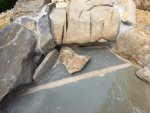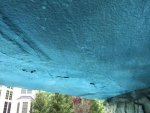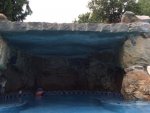My pool was built last year and there is a Grotto made out of rock. My contractor didn't have one solid bluestone slab that fit the top so he put on two pieces (one of which covered most of the Grotto). He cemented the two pieces together. You can see the cement in the picture.  . I noticed water seeping through last year so he redid the cement. That stopped the problem until this summer when I noticed water seeping through and more importantly, I saw that the top of the Grotto (when inside) was flaking and little pieces were coming off. Pictures below.
. I noticed water seeping through last year so he redid the cement. That stopped the problem until this summer when I noticed water seeping through and more importantly, I saw that the top of the Grotto (when inside) was flaking and little pieces were coming off. Pictures below. 


My contractor showed up and immediately told me he's never seen this before and it must be my SWG and I had to get rid of it immediately. He then told me the salt was affecting the structural integrity of the Grotto and although it would be fine for many years, after 15 years or so there could be a problem. I told him my Salt was 3000 PPM and even without a SWG it would likely be at 1000 PPM (I learned that from this cite - I hope correct) and I didn't want to get rid of the SWG. He then said after some thinking that he could clean the flaking and try sealing the top (on both sides) and that I should do it every other year. He also suggested that I have him seal the Moss rocks on top of the Grotto and the Moss rocks inside the Grotto. He proposes using a natural look non-color enhancing sealer. He would also redo the joint between the 2 Bluestone slabs. He wants $1200.
Questions:
1. Is the salt causing the top of the inside of grotto to flake? It seems to be happening where the water was coming through the seem as well as near the opening (perhaps when the water comes down the falls it gets pushed back a little inside). But it also is flaking in the middle of the top as well. Interestingly, on the other side of the top (where I can walk on it), I see no Flaking at all (although maybe the constant water flow would wash evidence of that away?)
2. If I seal it (and that seems to make sense to me), do I need to do the Moss rocks on top of the Grotto and inside the Grotto?
Thanks everyone
 . I noticed water seeping through last year so he redid the cement. That stopped the problem until this summer when I noticed water seeping through and more importantly, I saw that the top of the Grotto (when inside) was flaking and little pieces were coming off. Pictures below.
. I noticed water seeping through last year so he redid the cement. That stopped the problem until this summer when I noticed water seeping through and more importantly, I saw that the top of the Grotto (when inside) was flaking and little pieces were coming off. Pictures below. 


My contractor showed up and immediately told me he's never seen this before and it must be my SWG and I had to get rid of it immediately. He then told me the salt was affecting the structural integrity of the Grotto and although it would be fine for many years, after 15 years or so there could be a problem. I told him my Salt was 3000 PPM and even without a SWG it would likely be at 1000 PPM (I learned that from this cite - I hope correct) and I didn't want to get rid of the SWG. He then said after some thinking that he could clean the flaking and try sealing the top (on both sides) and that I should do it every other year. He also suggested that I have him seal the Moss rocks on top of the Grotto and the Moss rocks inside the Grotto. He proposes using a natural look non-color enhancing sealer. He would also redo the joint between the 2 Bluestone slabs. He wants $1200.
Questions:
1. Is the salt causing the top of the inside of grotto to flake? It seems to be happening where the water was coming through the seem as well as near the opening (perhaps when the water comes down the falls it gets pushed back a little inside). But it also is flaking in the middle of the top as well. Interestingly, on the other side of the top (where I can walk on it), I see no Flaking at all (although maybe the constant water flow would wash evidence of that away?)
2. If I seal it (and that seems to make sense to me), do I need to do the Moss rocks on top of the Grotto and inside the Grotto?
Thanks everyone


 for Giuseppe.
for Giuseppe.